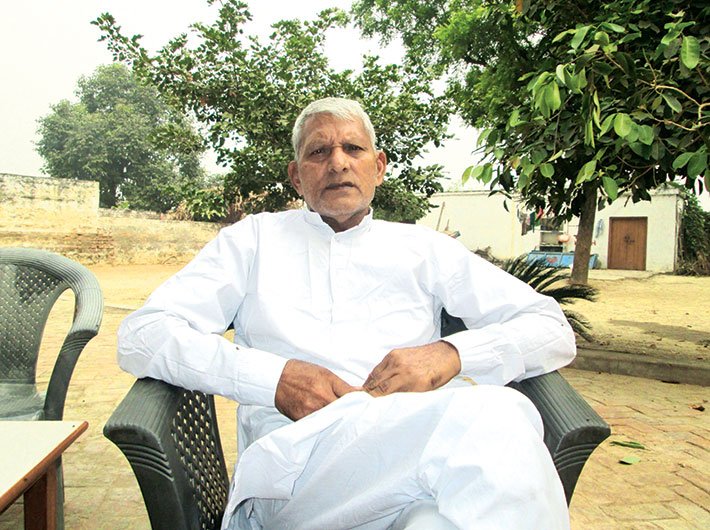Ground reports from the notorious hot spots of communal fault lines in western UP show a picture more nuanced than plain ‘Ganga-Jamuna tehzeeb’ or the simplistic notion of communal polarisation
Political leaders are crying hoarse; TV debates are causing rage; twitterati and the virtual world of internet are agog with sharp opinions on who is secular and who is not. Suddenly the Indians seem to be at war with themselves. Is it the same on the ground zero – the hinterlands of this vast nation? Governance Now travelled to villages in western Uttar Pradesh which have recently witnessed incidents of violence, apparently engineered to trigger communal violence, to find out. Contrary to the picture of doom painted in the national media, people in villages are trying to – and often succeeding in – maintain amity. Efforts are on to move on and to mend broken hearts and bonds. Here is a travelogue after a journey through these villages:
“I feel so ashamed of this”
Talheta, Ghaziabad District
Our first stop is Talheta village, close to the bustling Muzaffarnagar town though it is part of Ghaziabad district. Like most of the area, the village is located amidst sugarcane fields and land rendered fallow after the recent paddy harvest. “The village has existed for more than 1,500 years,” says Hariraj Tyagi, elected village head. Like others, 69-year-old Tyagi was visibly shaken by a macabre incident on October 23, in which the body of a Muslim village woman, Shamma Parveen, was found dug from the grave where it was buried a day before.
“I feel so ashamed of this,” says Tyagi, sitting in the huge compound of his large house located in one of the paved lanes of the village. “Police are yet to make a breakthrough in this case, though everyone knows it was done to whip up communal tension.” Tyagi, who is recovering from a paralytic stroke, says, “Maybe it is the handiwork of some outsiders. But I am more worried thinking what if the culprit is someone from our village.”
Talheta is home to about 12,000 people of whom only a few hundred are Muslims. The Muslims, mostly artisans and skilled workers, are spread across the village and don’t live in a ghetto.
Tyagi walks us down to Shamma’s house, located close to his own. Raisa, the dead woman’s sister-in-law, speaks to us in front of her extended family. Shamma was 28, had three children and was expecting her next. The ultrasound scan showed that her foetus was growing in fallopian tube instead of uterus. Doctors had warned her of this freak pregnancy. On October 21, Shamma became very sick and was rushed to the hospital. On the way her fallopian tube had burst. She died in the hospital the same day and was laid to rest in the village cemetery the next day.
Next morning, a few women who had gone to the fields for defecation, had spotted the naked corpse of Shamma. Someone had dug the grave, dragged the body out to about 10 feet and removed it’s shroud. The women informed her family. Shamma’s husband Javed and his two brothers had rushed to the cemetery; soon, all the villagers reached too.
The bereaved family was devastated to see this scene. Tyagi, who had also reached the spot, was thinking about the possible motives of those who did it. He remembered how in the past villagers would run away at the sight of a body. In his younger days, a gang of highway robbers was active; its members would kill their victims and throw the body in the fields of Talheta . “Villagers would be too scared to lift the body and dump it into common land to avoid police investigation,” he recalled.
He thought, probably, nobody from the village would do it. “It did not seem to be a prank of some drunken urchins or done by animals,” he said. The time spent and effort involved in digging a fresh grave, lifting the body from the deep, dragging it away and removing her clothes was done with definite motives, he said.
Shamma’s family is nervous though all the villagers have strongly stood by them in this hour of grief. “Bhai sahib (Tyagi) had been visiting us despite his bad health,” Raisa said. She, however, admits that a sense of insecurity had gripped the family. “My three children (including a daughter) had enjoyed freedom but now, I wonder, if things would remain the same,” she says.
Tyagi on the other hand is perturbed over the changing attitudes of younger people in the village. “People have become narrow-minded,” he rues. Giving an example, Tyagi says, during the filing of nominations for the just concluded panchayat elections, a villager had raised a question, “Why are Muslims using the Tyagi surname?”
Given his stature of a patriarch to the villagers, Tyagi had scolded him, “Do you change your name? And why should they? Mind you, you are their sister’s sons.”
He narrated the story of their origins to the gathering. It goes like this: Once there was an omnipotent Tyagi man, who brought down the Ghar Ganga (a tributary of the Ganges flowing nearby) to earth. He had three sons –Vijay Singh, who founded village Bijoli, Kharak Singh, the founder of village Karkodha and Tadak Singh, the founder of village Todi. Talheta was founded by their only sister’s son. While in Todi, people converted to Islam, they continued to use their pre-Islamic surnames and treat people around as their ‘relatives.’
It seems once the Gujjars and Tyagis of the area had a quarrel. The Gujjars announced they will not allow the Tyagis to undertake the annual pilgrimage to Gagool lake. “Our forefathers felt helpless,” said Tyagi. The villagers of Todi, the Muslims, took up cudgels on behalf of their Hindu relatives. “Todi people had licensed guns and arms. They dared the Gujjars to touch any pilgrim from Talheta and escorted our forefathers to Gagool for taking a holy dip.”
His nephew Shekhar Tyagi, who owns a jaggery manufacturing unit in the village, is listening to the conversation. At the end, he abruptly announces, “But one thing is clear: 85 percent people in the village have turned to BJP.” He leaves abruptly and keeps us guessing about the context of his one-liner.
“I have nothing against Hindus...”
Shahpur, Muzaffarnagar
The stretch of National Highway 24 from Delhi to Muzaffarnagar is a showcase of shining India. The wide highway is lined with swanky shopping malls; global eateries like KFCs and MacDonald outlets and colleges offering engineering, medical and management degrees for a price. Presence of high-end car showrooms gives one an idea about the prosperity in the region.
We travel on the macadamised road for about 10 km to reach Shahpur village. Last year a tented colony housing Muslims who had fled their homes in the wake of the infamous Muzaffarnagar riots of August 2013, had existed here. Some 150 families belonging to Kakra village lived in the camps in abysmal conditions. The tents were pitched on a marsh and the winter had made things worse for the inmates.
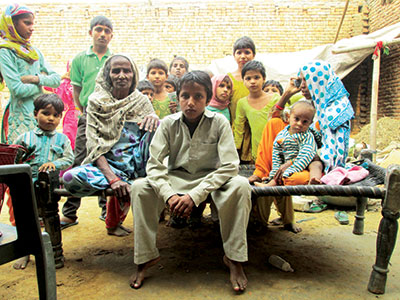
Jannati and her grandchildren in their new home at Shahpur
Today, only a few tents remain – they too belong to those who are in the middle of house building. Mostly single-storey brick houses have sprung up here. It seems a small time builder – who happened to be a Muslim – had seen a business opportunity in this. As soon as the UP government gave '5 lakh to each riot-affected family to build their houses, the property dealer had filled up the marsh and offered plots to the beneficiaries.
“We paid through our nose for this land,” said a local. “However, the builder was kind enough to give us a plot for building a mosque free of cost.” A Muslim ghetto has come up close to the shining India showcase.
Riots had broken out between the dominant Jat caste community and the Muslims in August 2013 after a single clash in a far off village Kawal between two groups of youth. Rumours and propaganda helped flare the situation resulting in death of 62 persons – 42 Muslims and 20 Hindus and fleeing of about 50,000 Muslims from their homes. For nearly two years, they lived in makeshift camps across three districts of Muzaffarnagar, Shamli and Bhagpath.
Surrounded by a brood of grandchildren in her son’s newly built brick house, Jannati is wondering about her life. A widow with four sons, she was escorted in a police truck out of Kakra village in the dead of the night.
“Village chief Ravinder Pradhan came to us and told us to leave the village as the Jat landowners were planning to kill Muslims to avenge the killings of three of their community members in a faraway place,” she told me.
Jannati and her children had worked in fields and homes of rich Jat farmers. “Later the Jats asked us to return to our village but nobody is ready to take responsibility for our safety,” said Jannati, whose two sons have built homes in the new place. Her former employers had initially faced acute labour shortages and wanted them to return. “Now they are using migrant labour and other lower caste people for farm work, and may be also paying them more,” she said.
Interestingly, the unlettered Jannati has no bitterness against any community. She says that she was overwhelmed to see people of all faiths flocking to the camps with essentials and goods. “I have nothing against Hindus, because majority of people who helped us rebuild our lives were Hindus.” She remembers the Sikhs from Punjab who came with truckloads of blankets and warm clothing; a baniya from the nearby Khatauli village who sent rice and sugar for each family for many months and Rehana Baji, from the NGO Oxfam, who distributed quality relief material and did it justly and most systematically.
Her neighbour Mohammad Kamil has taken a vow never to return to his village. “Trust once lost can never come back,” he says. However, last year Kamil was overwhelmed with emotions on seeing his childhood friend Satinder, who is an army man, in the camp. “It was like a filmy scene – both of them hugged each other and cried,” says his sister-in-law.
Iqbal, a mason, who has built a two-room house, says rumour mongering is still on. “At times I get scared as to what will happen to the country if people do not live peacefully,” he says. Iqbal also asks as to why his name gets linked to Pakistan. “I am born and bought up here. I have never understood as to what I have to do with that country.”
He is also scared on the beef issue. “I am for total ban on the beef. This will save us – the poor Muslims,” says Iqbal. He wonders as to why governments and organisations making a Hindu versus Muslim case out of availability of beef are not realising that the cattle are mostly sold by the Hindus in the market for slaughter. “Why kill Muslims and not punish those Hindus who sell their cows for slaughter in a market that is solely driven by money?” he asks.
The groundswell of support for the riot victims had seen a local leader donating '1 lakh each to the 27 girls who were married in a community wedding in the camp. Sadly, the money only added to their woes. According to activist Mohammad Saleem, many a family of the grooms were hoping to get 1 lakh from the brides. ‘The money was in the name of the girl and there was no way she would give it to them.” This led to many of the girls returning to their families. “We had to do several rounds of counselling to bring peace between the couples,” says Saleem, who works for the rehablitation of the riot-victims.
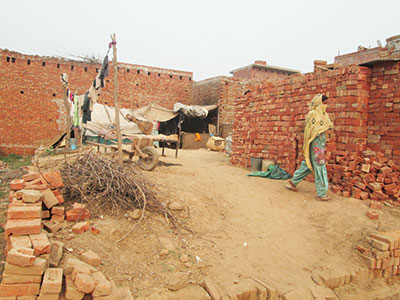
Half-built houses in the Muslim ghetto of Shahpur
Later, when 157 more girls from the camps got married, they were gifted '15,000 each. ‘ This was discrimination and many of these girls have been divorced by their husbands for not bringing '1 lakh.” Saleem said.
In the meanwhile, Jannati had to send her 9-year-old son away to a Muslim seminary and now none of her sons are ready to look after her. “Who will look after old people like me,” she asks. Her grandchildren study at the local madrasa, which has sprung up recently.
“When Muslim neighbours had to flee, we looked after their cattle”
Kutba, Muzaffarnagar
A few kilometres away lie the twin villages of Kutba-Kutbi, where eight Muslim shopkeepers were killed by a marauding mob during riots. “It was the bleakest day in the history of our village,” says Ashok Kumar, village head, Kutba. He claims the villagers were not involved in the killing of Muslims, who had become target of a mob which was returning after attending a ‘mahapanchayat’ of Jats. This massive kangaroo court meeting was held soon after the Kawal clash, in which one Muslim and two Jat boys were killed, to ‘chalk out future strategy.’
As hundreds of angry Jats were returning from ‘mahapanchayat’ the police had blocked the road in front of Kutba-Kutbi to protect the Muslim-dominated villages on the way. The mob however took a detour through the narrow lanes of Kutba and spotted Muslims shopkeepers, with their tell-tale skull caps and flowing beards, and attacked them – 8 local Muslims had died even before others realised asa to what was happening.
Ashok Kumar sits with village elders around a hubble-bubble discussing the tragic turn of events. A lone woman Pushpa Devi, who is Kumar’s sister, is also part of the debating group. “All the Muslims fled the village in the wake of the killings. We too were equally shocked by the killings, as we (Hindus and Muslims) had always lived like brothers,” Kumar says.
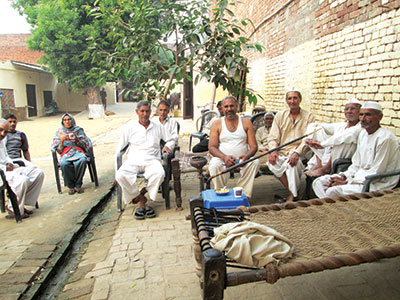
Ashok Kumar, village head of Kutba, discussing the aftermath of riots with villagers
The village elders, he claims, had almost persuaded the Muslims living in camps to return when the government announced a compensation of '5 lakh for those unwilling to return to their homes. “They backed out.”
“When Muslim neighbours had to flee, we looked after their cattle,” says Despal, a farmer. “I took care of the cattle of my two neighbours and the pradhanji was looking after some 25 buffalos belonging to our Muslim neighbours.”
Some of the Muslims have even resumed work with their former employers while others have reopened their shops in the village.The goodwill of neighbours is fine, but the Muslims have reasons to feel insecure - the rise of controversial politician Sanjiv Kumar Baliyan is just one. Baliyan, a junior minister in the Narendra Modi cabinet, belongs to Kutba. He is an accused in the Muzaffarnagar riots – alleged to have made an inflammatory speech at the mahapanchayat.
A Muslim not willing to be named, says, “Five years ago Baliyan had secured 1,700 votes in a panchayat election and lost. He was working as a vetenarian in Haryana government and nobody knew him. But after the riots, he contested Assembly elections and won with a margin of about four lakh votes. Now he is a powerful minister and this is not something that makes me feel safe in my village.”
“He would always say Ram-Ram to me”
Bisadha, Dadri
Dadri town is just 60 km away from the national capital. Taking a detour of a few kilometres via a narrow yet pucca road along a canal takes us to Bisadha, a sprawling village of 12,000 people. It is here that a lynch mob had killed their neighbour Mohammad Akhlaq, a 50-year-old Muslim, whom they suspected of killing a calf and storing its meat in his refrigerator on September 28.
Here, on the surface everything seems normal; children in uniform are loitering around the school, women carrying stuff to and from the fields are seen resting under the trees and old men sitting idle by the canal side. Yet talk to a few people and the guilt and anger at what had shot this quaint village into national headlines last month comes to the fore.
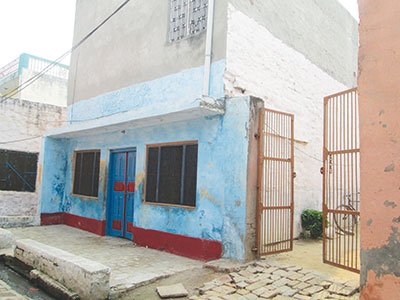
The house of Mohammad Akhlaq in Bisadha
People advise us not to go to Akhlaq’s house as nobody lives there. Also they warn us about the police presence in the area. Two policemen sitting in a shop at the end of the road give us a clue to the house. “We are on duty here and would not speak to the media,” one of them said.
Akhlaq’s two-floor house is in a narrow street of a Hindu neighbourhood. From the first floor of the house, the inmates could have had a commanding view of neighbours’ compounds. Now nobody lives here. Even Akhlaq’s two brothers, who had lived in the same neighbourhood, have shifted. Policemen occupy the main room of the house.
“Akhlaq’s house is located on a plot given to the family by my great-grandfather-in-law,” says a woman neighbour, whose son is accused of killing Akhlaq. The woman summons all her neighbours whose sons are also behind the bars for the ghastly crime. They all believe that the meat recovered in the fridge was beef and not mutton. The government, they allege, is soft to Muslims and therefore telling a lie.
“Dekho, woh to Pakistan bhi gaya tha aur kisi ko bataya bhi nahin (Look, he had even gone to Pakistan and never told about it to anyone),” says a woman, not willing to give her name. “Police have even recovered his air ticket for Pakistan from his home,” she informs us. Is going to Pakistan a crime? “Don’t you know what all they teach you there (In Pakistan)? Hamein kya pata woh aur kya kya kar raha tha wapsi ke baad (what do we know of his activities after his return from Pakistan)?”she retorts.
At this, an aged neighbour snaps her conversation. “I will tell you the truth,” she tells raising her otherwise feeble voice. “He was a very nice man. All in the family were decent people. He would always say Ram-Ram to me and inquire about my health.”
However, other neighbours say the memory of that night still haunts them. They are living with the fear that some day, they may be attacked (by Muslims). “I didn’t open my gate for three days after the incident,” says one of them. Akhalaq’s family had enjoyed good relations with neighbours and their daughter was friends with all the girls, says a young girl studying to be a pharmacist, whose brother is also an accused in the murder. Another neighbour said that for three days her family did not cook or eat food after Akhlaq’s death.
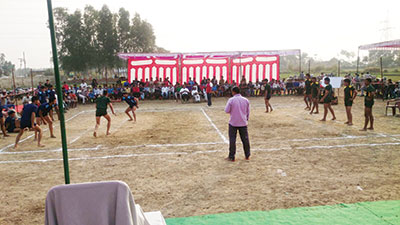
Hindus and Muslims playing
kabaddi in Bisadha
It seems on the fateful day, a mob of young neighbours had raided Akhlaq’s house at about 9.30 pm. It was a mob of some 50 youth, mostly neighbours and also some unidentified people. According to Sanjiv Singh Rana, elected village chief, they had invaded his home on the suspicion that he had slaughtered a calf and kept its meat in the refrigerator. Rana claimed that police had indeed recovered an animal hide and a set of hooves of ‘some animal’ from the house. “I could not make out whether it was of cow or some other animal,” he said.
In a matter of minutes, the mob had bludgeoned Akhlaq to death and seriously wounded his younger son Danish. The announcement made by a temple priest, who has since disappeared from the locality, that beef was indeed recovered from Akhlaq’s house added fuel to the fire.
Sangram Singh, a rich landlord, tells us that Akhlaq’s murder was an unfortunate incident and does not reflect the ethos of the village. “Had it happened in the daytime, Akhlaq would not have died, for the senior villagers would have definitely interfered and restrained the mob, mostly comprising young boys.
“Akhalaq’s son Sartaj was my friend. Each time he would come for holidays from his Air force job, he would meet all of us,” says Sangram Singh.
He says that the villagers were shocked and ashamed of the incident. Yet they wanted to move on. “But these daily television debates keep mentioning the incident to bog us down all our lives.”
The village has a population of 400 to 500 Muslim families. “We are trying to erase from our collective painful memory of that day,” the village chief said. He is in touch with Akhlaq’s family and his brothers. The family has shifted to the Hindon airbase, where Sartaj was allotted an accommodation by the Indian Air Force.
Village chief Sanjiv Singh Rana said everyone in Bishada, including Akhlaq’s family wanted to move on. To start the process of healing, Rana had organised a two-day kabaddi tournament in the village aptly named “sadbhawana Kabaddi tournament” from November 9. “I had personally handpicked Hindus and Muslim wrestlers for the event to make it a show of unity,” says Rana.
Rana and people of Bishada are making an all out effort to make sure that a ghetto does not come up on outskirts of their village.

